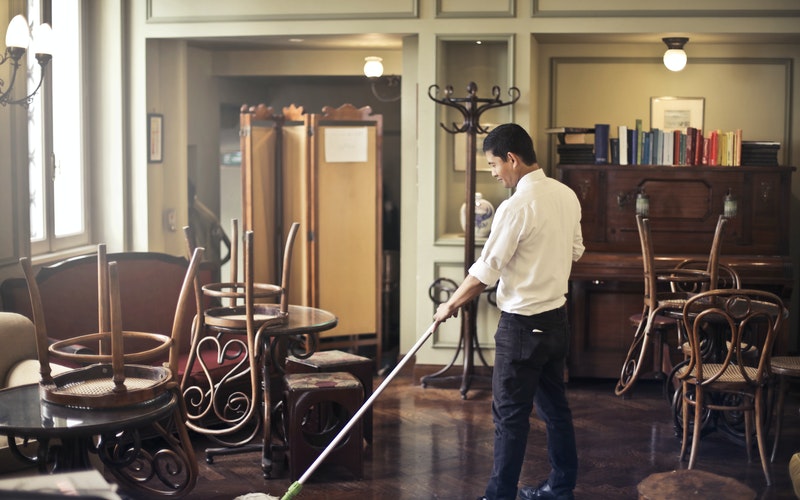The cleanliness of your restaurant is just as important as the food you serve. The entire place, from the front desk and dining areas to the kitchen and storage space, needs to be immaculately clean and sanitized if you want to look after the health and safety of your customers and staff. Routine visits from local public health inspectors also mean you need to maintain high standards of hygiene. Failure to do so could result in a fine or the closure of your business. In light of this, whether or not to hire restaurant cleaning services is an important consideration.
To be successful in the restaurant trade, you can’t afford to let hygiene standards slip because there is a lot of competition. If you don’t have a clean place, your customers will simply move onto the next eating establishment. Statistics reveal that the number of restaurants in the US is 660,7455. There are 307,940 chain restaurants and 352,815 independent restaurants. Restaurant cleaning services are part of the commercial cleaning services market, valued at $117.3 billion. Statistics reveal that although the market has declined by 1.6% due to COVID-19, it will rapidly recover with a 7.4% gain for 2021 because of the additional demand for clean and sanitized environments.
Advantages and Disadvantages of Hiring Restaurant Cleaning Services
There are two main types of restaurant. The quick serve restaurant (QSR) prepares and serves food quickly to the customer. It is commonly popular as a “fast food” restaurant. The other type is a full service restaurant (FSR). It offers table service for customers who prefer to sit in the restaurant and enjoy a meal in a more leisurely manner. Regardless of what type of restaurant you own or run, the same high standards of hygiene and cleanliness should apply. The question is, should you employ professional restaurant cleaning services? Here are the advantages and disadvantages to help you decide.
Advantages
Save Time with Restaurant Cleaning Services
You will save valuable time if you hire restaurant cleaning services and hand over the responsibility to the professionals. If you run a busy restaurant, your focus is on providing delicious food, perfect service, and a great experience for the customer. Likewise, your staff will each have their own duties and responsibilities to ensure the smooth running of the restaurant. Even if their job includes wiping down tables between sittings and tidying up throughout the day, a quick clean-up is not on the same level as that provided by professional restaurant cleaning services.
Professional Cleaning Experience
If you hire a reputable professional cleaning firm, you benefit from their expertise and experience. Whether it is office cleaning services or restaurant cleaning services, you can be sure that their methods and experience will clean your establishment to the highest standards. It will happen in the most time-efficient manner. No corner should be left unclean in your restaurant. This includes storage areas, walls, ceilings, high shelves, and door handles that easy to overlook.
A reputable professional cleaning service provider will have a checklist of jobs and procedures that it carries out carefully and efficiently. For example, DetailXPerts offer a sanitization program that uses steam technology to deliver a superior clean in a methodical manner.
Restaurant Cleaning Services Use Specialist Equipment
A lot of time and effort goes into cleaning a restaurant. Dining chairs and tables, countertops, the kitchen and equipment, storage areas, floors, windows, and so on. The job becomes so much easier and quicker with the aid of commercial cleaning equipment. A professional cleaning business with a good reputation will have high-grade equipment, such as commercial vacuum cleaners, floor buffers, and steam cleaning technology to help them do a superior job.
Flexible Cleaning Schedule
If you want to clean and sanitize a restaurant properly, ideally it should be done when the restaurant is closed. Chefs, kitchen staff and servers need to work without interruption during opening hours. Likewise, customers want to enjoy their meal in peace without someone mopping the floor around them. Restaurant cleaning services will have a flexible schedule to suit out-of-hours requirements. Get them to come in before you open the restaurant or after closing time.
On-Site Storage for Cleaning Fluids and Equipment Is not Required
According to reports, one of the most commonly cited violations during routine restaurant inspections is improper storage or use of toxic items in the kitchen. For example, storing cleaning fluids next to food and/or food preparation areas. Restaurant cleaning services will bring and use their own commercial cleaning supplies. You are not required to store them on your premises. If you decide to hire a cleaner as part of your regular staff, you will need to find safe, secure storage space for not just cleaning supplies, but also all cleaning equipment that goes with the job.
Disadvantages
Restaurant Cleaning Services Add to the Cost of Running a Restaurant
You will need to add the cost of restaurant cleaning services to your outgoings. If you don’t want to pay a professional cleaning firm, it is possible to cut costs by tasking each restaurant employee with specific cleaning responsibilities. However, you must make sure that the extra workload doesn’t impact on their well-being or their ability to carry out their other work in the restaurant.
If you decide to employ someone as a full-time cleaner for your restaurant, you will need to account for their salary. Additionally, you need to prepare and have a back-up plan for this person’s sick days. Finally, you will need to allocate a budget for all the additional cleaning supplies and equipment. In light of all of this, budgeting for a professional cleaning service provider might be money well spent in the long term.
Strong-Smelling Cleaning Products
It is important to find out what type of cleaning products a professional cleaning service business uses. Some heavy-duty products are chemical-based with either a strong or perfumed odor. While this may not be an issue in larger office buildings, it is not desirable in a restaurant where people either prepare of eat food. Instead, you could employ restaurant cleaning services that clean, sanitize and kill viruses using steam technology and/or specific EPA-registered disinfectants that are odor-free.
Conclusion
Work out your budget. Employing a full-time cleaner on your staff may be more expensive than hiring restaurant cleaning services. If you are tasking employees with additional cleaning jobs, make sure they have the time to do the job well. This is more important than ever. The extra cleaning measures and guidelines introduced after the COVID-19 pandemic are likely to remain in place for a considerable time as a precaution. This is not just in restaurants. Office sanitization, temple cleaning and vehicle detailing are also encouraged to keep people safe.
If you decide to use a professional cleaning service provider, it will give you peace of mind. Your restaurant will be as clean and sanitized as possible. This will also provide extra protection for your business when the routine restaurant inspections from health officials take place. Above all, you’ll know you are looking after your staff and your customers by providing a sanitized and safe environment.
If you are interested in hiring professional help, call DetailXPerts at 877-317-9737 to discuss your restaurant cleaning needs. Find out how we can help with our professional commercial cleaning and sanitization services.
To get a better idea of how our services work, view DetailXPerts’ YouTube video demonstrating our cleaning and sanitization program, which utilizes steam technology and EPA-registered disinfectants.





